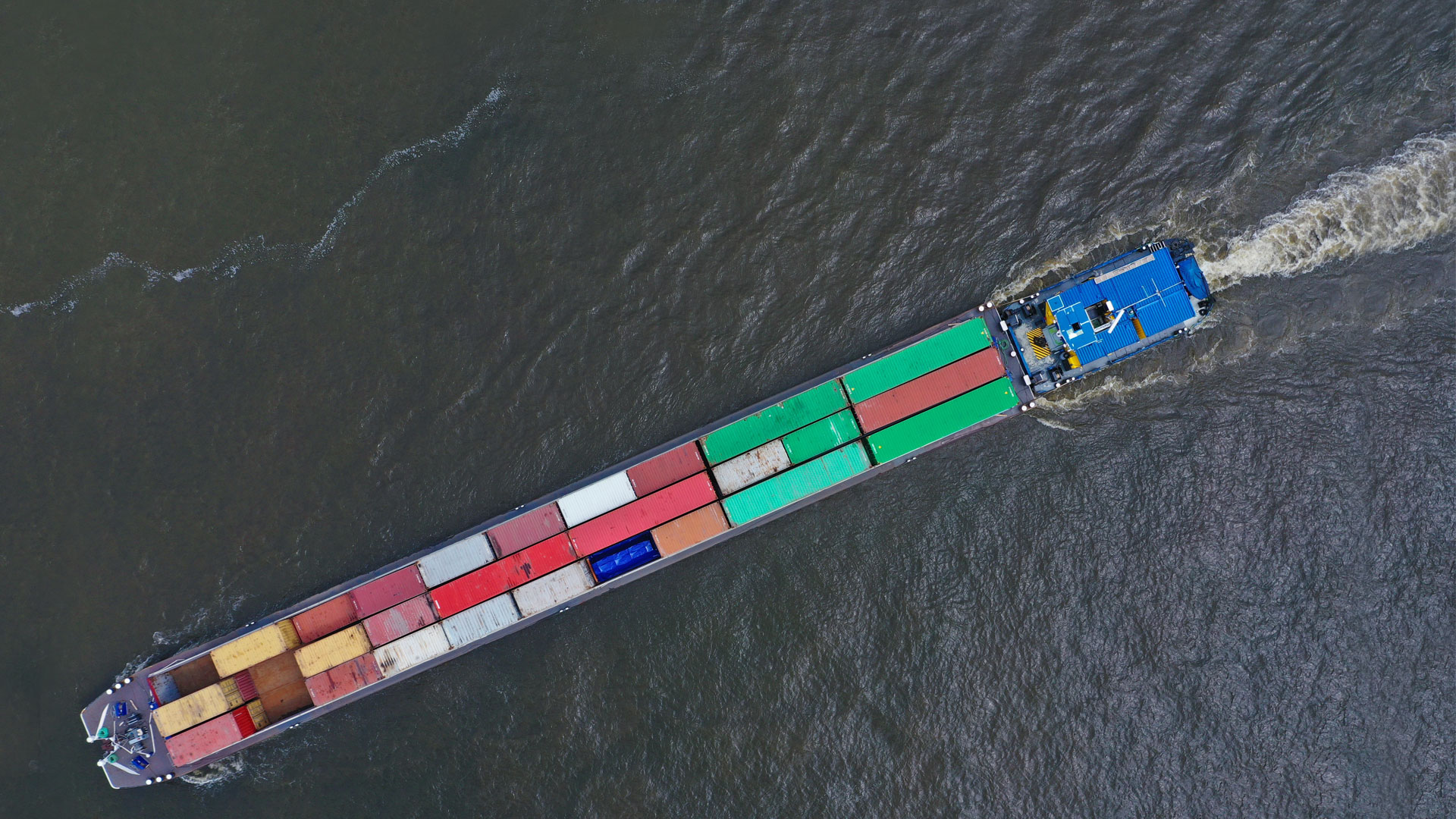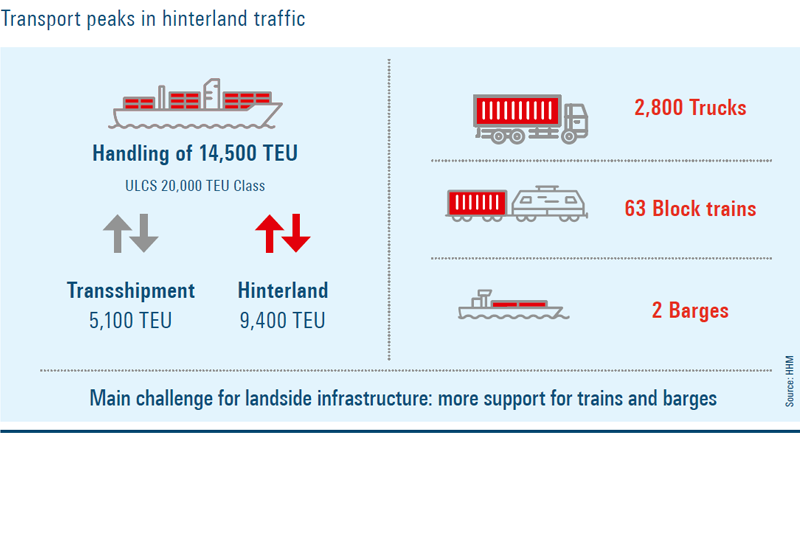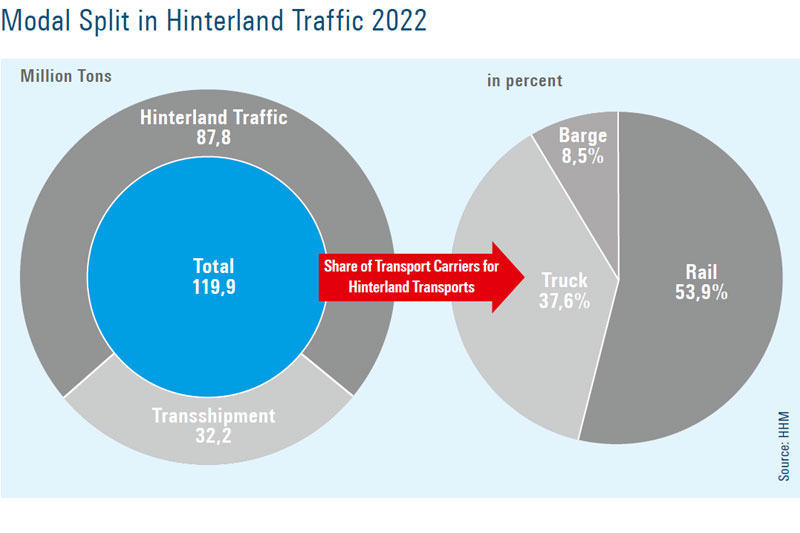Vital arteries for the Port of Hamburg
Whether rail, road or inland waterway – its hinterland services are the lifeblood of the Port of Hamburg.

No other port in Europe possesses such a unique rail infrastructure as the Port of Hamburg. 200 freight trains per day roll along its tracks. These distribute freight in Europe, on the one hand, and ensure delivery in the Port of Hamburg, on the other. Hamburg Port Railway therefore conjures up many a superlative. With almost 300 kilometres of track and over 750 integrated sets of points, Hamburg’s rail port is among the world’s largest.
Last year alone, according to HHM – Port of Hamburg Marketing, freight trains handled 2.7 million TEUs – Twenty-foot Equivalent Units. Include bulk cargoes, and the numbers look even more striking. With 47.3 million tons, rail achieved its third best result, after 2021 and 2019 – and this despite worldwide crises.
“For the Port of Hamburg, rail is the top carrier for hinterland services. It is therefore of the utmost importance for Germany as a location that this infrastructure be expanded as rapidly as possible. This applies primarily to the stretch between Hamburg and Hanover, since despite numerous economic crises, volumes on the Port of Hamburg’s hinterland transport remain constant,” stresses Axel Mattern, HHM’s CEO. Just released, the latest halfyear throughput returns underline that. In the first six months of this year, rail shifted 23.1 million tons. This made rail the outstanding carrier in the Port of Hamburg’s modal split, as it has been for some years, with half of total transport volume.
„Rail transported
23.1 million tons
in the first six month
of this year."

Throughput totals for inland waterway shipping in the Port of Hamburg may be somewhat lower than those for rail. Yet it is among Germany’s largest inland ports. Last year, 7.46 million tons of freight crossed the quaywalls for inland waterway craft, this volume also including 117,000 TEU. Many shippers based near inland ports are happy to use this form of transport for containers. A modern push tow, or combination of tug and barges, can on average shift over 160 TEU. This provides scope for an ecological component of the transport. Fashion group New Yorker – see page 14 – demonstrates how this works in practice . “For us, the inland waterway vessel has three unbeatable arguments in its favour: Price, Reliability and Ecological Footprint,“ says Stefan Heidler, New Yorker’s Logistics Manager. In addition, its role in transporting bulk cargoes, as well as shifting heavy and out-of-gauge shipments, makes the inland waterway craft of vital importance for the German economy .
Yet to enhance inland waterway shipping’s potential, waterway infrastructure urgently requires investments. Among these is a further expansion of HR capacities. Only recently the WSV – Waterway and Shipping Administration in Osttrog discovered a crack at the Scharnebeck Ship Lift , causing closure of a trough. At the time, the second trough on the W. side was still being repaired. That led to a brief total shutdown. Such occurrences hamper inland waterway shipping.
„One push-tow
replaces about
100 trucks."
Yet inland waterway shipping is of immense significance for the Port of Hamburg and the Metropolitan Region, also contributing to reducing emissions. For instance, one push-tow replaces about 100 trucks. If services had to be transferred back to road, that would create an extremely tight traffic situation on roads and in the port area. “It is essential to secure an inland shipping infrastructure fit for the future, which also applies to import/export transport capacities on seaport- hinterland services. These must be the aims for German transport policy and for infrastructure operators in and around the Hamburg economic area,“ says HHM’s CEO Mattern. Even though there has been an Elbe Master Plan since 2017, too little has been done in recent years, he adds. Failure to implement the plan caused non-navigability of Elbe between Lauenburg and the Czech Republic, with a corresponding decline in cargoes and growth in traffic on the Elbe Lateral Canal.
Trade associations, inland shipping companies and business in the Port of Port of Hamburg are therefore vehemently demanding that the new Lüneburg Lock be covered by the Authorization Acceleration Act or Genehmigungsbeschleunigungsgesetz. As matters stand now, however, the Federal government plans to include only specific road and rail projects in this. Waterway projects have hitherto not been considered at all. “In the interests of the economy, no more time can be lost with lengthy procedures and debates. We urgently require functioning infrastructure for inland shipping – both on the Elbe Lateral Canal and the Elbe. Then the inland waterway craft can still provide a large share of all transport,” stresses Stefan Kunze, Chair of the Elbe Alliance.
The autobahn network is one further component in the Port of Hamburg’s hinterland services. Much of the freight arriving in the Hanseatic City by seagoing vessels, remains in its Metropolitan Region. The A7 and A1 autobahns ensure that it is connected in both North-South and East-West directions. Yet capacities there reached their limits many years ago. Port business has therefore been longing for the building of the A26 East, which aims to relieve traffic in the port.
For one of Europe’s largest seaports, multimodal hinterland transport is a matter of course. Every form of transport has its justification, and is indispensable for transport to and from the Port of Hamburg. After all, rail, roads and inland waterways are arteries, not simply for the port, but also for the logistics chains that are so indispensable for a functioning economy.
